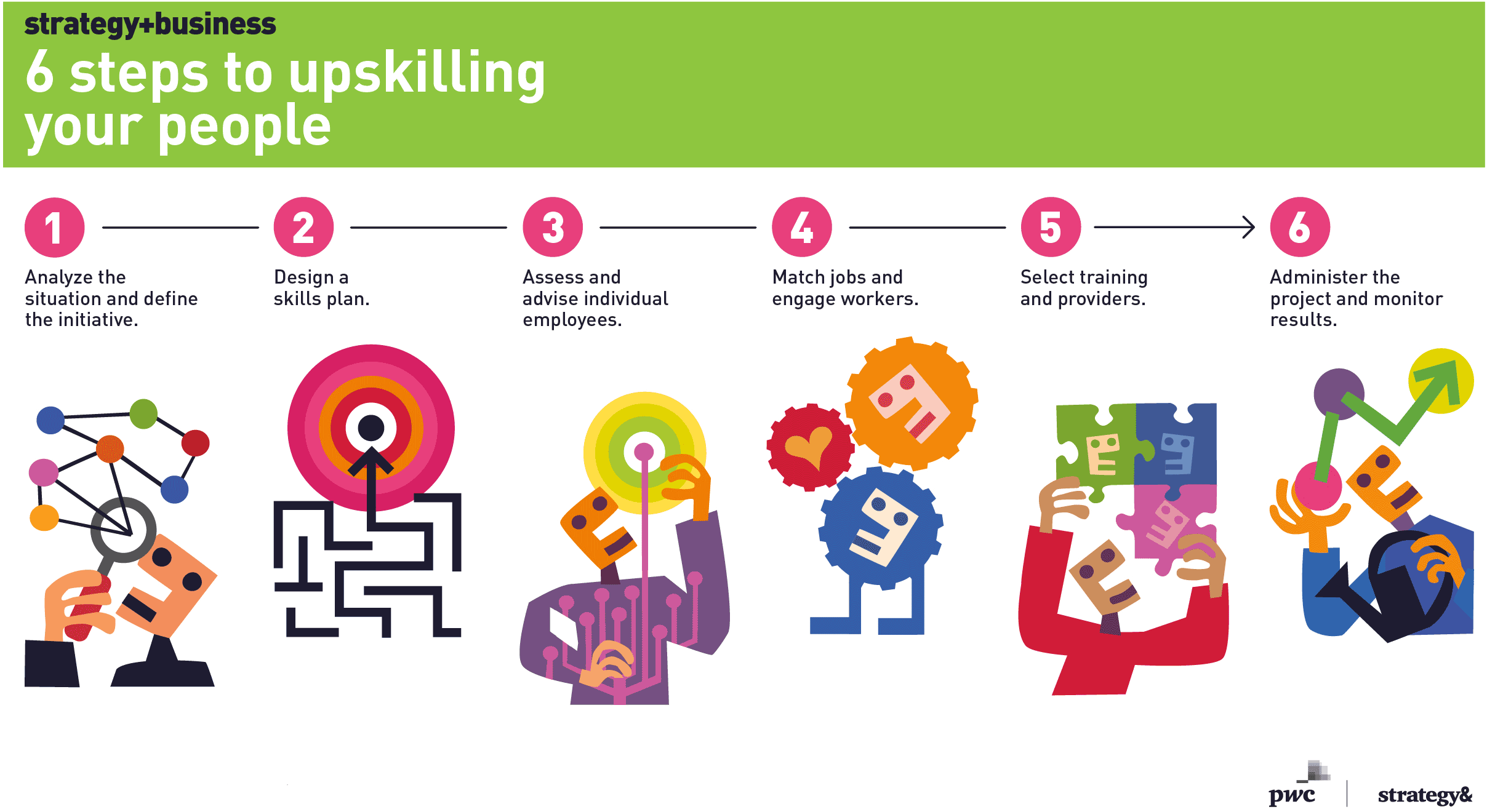A strategist’s guide to upskilling
Companies and local governments can unlock opportunity by working together to raise the quality of talent. See also “6 steps to upskilling your people.”

Imagine that you’re one of millions of people whose job is threatened by digital technology. You’re the compliance officer at a bank, an operations manager on an assembly line, a technical writer, a programming debugger, or a lighting coordinator for a photographer. Sometimes your job is so bound up in routine, you joke that it could be handled by a computer. Then the joke becomes reality. You are asked to help design the automated processes that will replace your position in a year.
You are shocked at first; then worried; and then, if you’re very lucky, you find out that an upskilling initiative has been set up in your company, perhaps in partnership with other organizations in your region. The initiative is made possible by advances in learning methods and analytics. It uses shared data about skills, tasks, and employment prospects to match people who would otherwise be laid off with new digitally oriented jobs and the training needed to fill them. To take a new job would mean changing roles, maybe changing companies, and undergoing an intensive 15-week training program. You talk it through with one of the initiative’s personal counselors, decide to apply for a position, and are accepted.
The training is tough, but your counselor keeps in touch with you throughout, offering encouragement and monitoring your progress. Around the seventh week, you meet with HR to discuss the on-boarding schedule. Then comes a three-month trial period in the new role, after which you are hired permanently. Your retirement and healthcare benefits carry over. You’re even paid a welcome bonus. You aren’t a layoff statistic; you are an example of the vital role upskilling will play in our turbulent digital economy.
Upskilling for the long run
The industrialized world is facing a skills crisis. On the one hand, automation is threatening many existing jobs. Hundreds of millions of young people around the world are coming of age and finding themselves unemployed and unemployable, while many older, long-established employees are discovering their jobs are becoming obsolete. A study published by the Organisation for Economic Co-operation and Development in 2018 estimated that 46 percent of all jobs have at least a 50 percent chance of being lost or greatly changed. A 2016 report from the International Commission on Financing Global Education Opportunity estimates that 30 percent of young adults will not graduate from secondary school with the skills they need to hold most jobs.
On the other hand, there is a severe shortage of qualified talent for the new digital economy. Jobs requiring knowledge of artificial intelligence (AI), robotics, and the Internet of Things are going unfilled in ever-greater numbers. Estimates suggest that U.S. software-related jobs (pdf) are growing at 6.5 percent annually — almost twice the rate of jobs in general — and that in Europe, there will be a high-tech skills gap of more than 500,000 unfilled positions by 2020.
Together, these two trends have broadened the gap between the employees of the present and the workforce of the future — hence the recent interest in upskilling. The term upskilling refers to the expansion of people’s capabilities and employability to fulfill the talent needs of a rapidly changing economy. An upskilling initiative can take place at the level of a company, an industry, or a community.
Upskilling is not the same as reskilling, a term associated with short-term efforts undertaken for specific groups (for example, retraining steelworkers in air-conditioning repair or locksmithing). Reskilling doesn’t help much if there are too few well-paying jobs available for the retrained employees. An upskilling effort, by contrast, is a comprehensive initiative to convert applicable knowledge into productive results — not just to have people meet classroom requirements, but to have them move into new jobs and excel at them. It involves identifying the skills that will be most valuable in the future, the businesses that will need them, the people who need work and could plausibly gain those skills, and the training and technology-enabled learning that could help them — and then putting all these elements together.
To someone accustomed to current forms of workforce training, in which resources are constrained and companies generally operate independently of one another, an upskilling initiative might seem massive and unaffordable. But it is feasible — although the process often means confronting long-held assumptions about human capital and organizational practices. And the payoff can be immense in economic results, overall quality of life, and increased opportunities. Not only do people move to new jobs, but the jobs are better and less likely to be rapidly automated out from under them.
A growing number of business leaders see the value of upskilling. In PwC’s 22nd Annual Global CEO Survey, 79 percent of the respondents said a shortage of skilled talent was one of their top three worries, and 46 percent said upskilling was their preferred solution. The same survey has found that aggregate chief executive confidence in their own company’s performance is a leading indicator of economic growth, and arguably there is no surer way to build CEO confidence than to raise the talent level.
Unless a solution is put in place, the social impact of job loss — for individuals, the businesses and organizations that employ them, and the communities around them — will be even more staggering than it has been in the past. Some of the most effective upskilling initiatives take place at a community level, where there are economies of scale, a broad range of opportunities, and an incentive for government to raise general prosperity. Government, business, and not-for-profit organizations work together in these partnerships, often in new ways.
Even if it is tackled by a single company, upskilling is not a one-time endeavor. In this time of rapid technological change, every member of the workforce, from the front lines to the C-suite, needs to continually expand or augment his or her skills. One way this can be done is through “gamified” apps that allow people throughout the enterprise to build their skills and create new software-based tools for others to use.
Those skills are not limited to the realm of technology. A recruitment manager in a large French utility company put it this way: “I now understand that we must change our recruitment criteria. We have spent much time investigating hard skills, like accountancy, but we must now look at soft skills and the ability to learn and grasp new knowledge, so that we build a workforce that can evolve into the new jobs we cannot even forecast today.” In short, upskilling and intellectual renewal need to become commonplace for any company or community that expects to thrive.
Costs and benefits
At first glance, the expenses of upskilling appear daunting. The World Economic Forum estimates a cost of US$24,800 per person to retrain displaced workers in the United States. Our own experience suggests those numbers or even higher costs are realistic for high-tech industries or smaller groups. But for large efforts (such as regional efforts), the expense might drop to $5,000 or $10,000 per person.
The cost of training is just one element, and not necessarily the most expensive one. To bring someone to a new level of competence — for example, from a midlevel accountant to a cybersecurity agent or data analyst — might take nine weeks. During that time, individuals need financial support, and their current job must be covered with a full- or part-time substitute. The company also may need to set aside funds to ensure that employees who switch to new jobs receive the same salaries they made previously. If the budget forecasts that, on average, only hundreds of dollars will be spent on each individual, it is not an upskilling initiative. It is skills maintenance.
But the expense of upskilling should be considered in the context of the alternatives: severance costs for laid-off workers, plus the time and costs involved in finding, recruiting, and on-boarding new people with the skills most in demand. Moreover, an upskilling program does not need to upgrade skills for the entire workforce at once. In any given year, only 10 percent of a company’s workforce is immediately at risk. If you target that group and successfully move them into new roles, you create a track record and garner further support. Within five years, moving at the same pace, you can reach close to half of the employees in a company. Focus on developing people, not saving jobs, because not all jobs can or should be saved.
Upskilling is especially cost-effective for communities. Skills mismatches have a direct impact on a nation’s GDP, taxation revenues, and social safety net bill. Analysis of return on investment for existing cases suggests that $1 invested in upskilling tends to return at least $2 in revenues or savings. Financing mechanisms include skills insurance plans (collecting contributions from employers) and tax incentives for participating companies and employees. In the end, if you regard workers as an asset worthy of investment, and recognize the value of being part of a community of adaptable and continual learners, a well-designed and well-managed upskilling initiative is extremely cost-effective.
Experience on the ground
Upskilling initiatives are typically championed by visionary leaders who have reflected deeply upon the long-term business and social elements that sustain growth in their region, country, or industry. Programs of this sort have been initiated in Bangladesh, Belgium, Brazil, Canada, Denmark, France, India, Ireland (pdf), Luxembourg, Mexico (pdf), Singapore, the United Kingdom, and the U.S. (most prominently in Florida). Most initiatives are relatively new and were launched with a rationale directly linked to the job risks of the new digital economy. They are already beginning to demonstrate significant results.
Consider, for example, the Luxembourg Digital Skills Bridge project, a case we at PwC know well because we were involved in developing it. Launched in 2018 with a wide range of stakeholders on board, including trade unions and trade associations, it began with the idea of saving money on unemployment costs by investing in building a cluster of digitally oriented industries and developing the relevant skills.
Only 10 percent of a company’s workforce is immediately at risk. Target that group and move them into new roles; within five years, at the same pace, you can reach nearly half of your employees.
This cluster-based approach required a great deal of up-front coordination. The Luxembourg ministries of education, labor, and the economy aligned on a common national skills strategy. The initiative assembled a group of digital apps and tools for all participants to share. Companies abandoned their existing “shotgun” approaches to training and agreed to foster long-term employability, even if that meant investing in employees who might move to other companies in the future. They also agreed to identify at-risk employee populations, to collaborate more readily with other companies (for instance, making it easier for incoming employees to keep their past seniority level), and to adopt more flexible human resources practices. Individual workers, for their part, took responsibility for their career in a way they might not have done previously: using the skills banks, investing their time in the training courses, and recognizing that without their participation in the initiative, they might not keep their job. For everyone involved — the employees undergoing training, the companies hiring them, and the leaders arranging this new reality — upskilling represented a leap into the unknown.
From the beginning, clear metrics were established: The Luxembourg Digital Skills Bridge would place 65 percent of the pilot project participants in new positions. It would thus justify the technical and financial assistance provided to companies and individuals. To facilitate communication and “self-branding,” there was a digital platform called MySelf; participants posted video profiles as well as documents about their skills and aspirations. The initiative covered 90 percent of an employee’s salary during the training period and a portion of the company’s training costs, ranging from 35 percent (for a new role in the same company) to 80 percent (for a move to an entirely new industry). Perhaps most important was the guidance, which consisted of 12 days per company in employee assessment and workforce planning assistance and up to 12 hours of coaching per employee in addition to the training.
“Upskilling has become…the indispensable response to the ongoing technological and economic transformation,” noted Nicolas Schmit, former minister of labor, employment, and the social and solidarity economy, who was a key sponsor of the initiative. “Luxembourg has made the choice of becoming an advanced digital society. This means a high level of investment into digital infrastructures…to help citizens as well as workers and entrepreneurs to be ready for the future. To do that successfully, we are convinced that confidence is key. This can only be achieved through dialogue with all stakeholders. It is the best way to make the digital society as inclusive as possible.”
A few other locales are beginning their own upskilling plans, each with its own focus. The Canada Job Grant program, a federal government initiative administered by the provinces, pays employers most or all of the costs for training their employees in workplace skills. In the Wallonia region in Belgium, Crédit Adaptation offers grants of up to €80,000 (US$90,000) every two years to companies facing change. India’s National Skill Development Corporation, established by the government in 2009, offers courses and job placement, and focuses on entrepreneurial opportunities for women. It is expected to fill 109 million job vacancies in 24 key sectors by 2022. And in the U.K., the Sheffield Skills Bank — funded by the European Union, the U.K.’s Business Investment Fund, and local government — has an overall goal of creating 70,000 new jobs and 6,000 new businesses by 2025. Although the programs are all worthwhile, there is often a key element missing, such as skills assessment or employee guidance — hence the value of a comprehensive approach.
Road map for an upskilling initiative
Our society’s intellectual capital may well depend on deepening our understanding of how to effectively design and implement upskilling initiatives. Below are six key action steps. They are typically conducted in the following sequence, so that each may build on those that came before.
1. Analyze the situation and define the initiative. Every situation is unique. Some upskilling efforts may begin as regional initiatives, driven by government leaders; others might start within a single enterprise, such as an automaker with assembly-line workers who may be facing layoffs. All will have some elements in common: a commitment to lifelong learning rather than the preservation of specific jobs, support for individuals undergoing change, and a reasonable time horizon, generally nine to 18 months, for the first round of activity.
Begin by convening candid dialogues with key stakeholders such as senior executives and HR leaders of participating companies, employee representatives, government officials as appropriate, and representatives of academic institutions or training resources. How confident are business leaders about their own company prospects and the potential mobility of their staff? Which industries are looking for talent and which have overcapacity? What types of skills are needed — purely technical skills, skills broadly oriented toward digital acumen, or soft skills such as team leadership and effective communication? How supportive of this effort are labor unions and regulators? Where will the financial and educational resources come from to support this initiative?
The initiative must coordinate decisions and actions on several levels at once: the individuals seeking better work, the organizations losing jobs, the businesses in need of skilled workers, the city or regional government, the local colleges or other education groups, and the community as a whole. To keep these activities aligned, a core group of sponsors and a project leadership team must manage the initiative and organize communications. There is also generally a technological component developing innovative, digitally enabled methods for gathering data, assessing skills, and facilitating lifelong learning.
Set quantitative objectives — for example, increasing the retention rate by 70 percent in a single company or involving 15 percent of the companies in a region. Indicate the desired return for the government, the company, and the individual. Also set non-numeric objectives, which articulate the positive future state and motivate people. These could include past or prospective case studies describing how the initiative makes job automation less risky, how it helps fill jobs that have been chronically vacant, and how it increases community spirit.
2. Design a skills plan. Many past reskilling efforts provided inadequate training and aimed it at the wrong population. Take a more focused approach. Base your priorities on the types of jobs that will be affected most by new technologies, the employees who are most at risk, and the businesses that have the most to gain.
Off-the-shelf analytic workforce planning tools can help you estimate the impact of new technologies on particular companies, the savings that automation will generate, the types of new skills that will be needed, and the number of months or years that it will take for these changes to happen. Customize your training accordingly. Depending on your strategy, you might specify technological training in robotics, materials, energy, or another specialization. Design each course within an overall upskilling initiative to focus closely on these strategic goals; you want your internally trained people to become as competent as those you might hire from outside, and to do so as quickly as possible, given the increasingly rapid pace of technological change.
The local companies’ HR functions should lead the way in implementing this step. In addition to managing the training and skill development process, this group can make sure that diversity is honored in terms of gender, ethnicity, age, and mix of professional and working backgrounds. Connect with organizations such as Women in Digital Empowerment, Girls in Tech, and Fit4Coding to find role models in the community who can help encourage workers to accept the challenge of learning unfamiliar skills.
3. Assess and advise individual employees. Some form of individual transformation will take place for participants, sometimes taking them out of their comfort zones. A considered assessment program that includes personal coaching and advice can go a long way toward assuaging employees’ fears and helping them move to a better position in the end. Quantify the skills of prospective employees, measure their career achievement, and ask about their personal and professional aspirations.
For each participant, create an individual skills development plan, defining the steps and training necessary to address the new job requirements or even make broader changes. For example, a bank employee could use this exercise to flag his or her intention to completely switch careers and be employed outside the financial industry.
Ideally, individual workers should feel they are in charge of their own process. In the French upskilling initiative CompteActivité, which was championed by President Emmanuel Macron, individual control is central. A law passed in August 2018 created an individual training account, in which workers can accumulate “training funds.” Employers provide €5,000 or €8,000 ($5,600 or $9,000) for nonqualified and qualified workers, respectively), over a 10-year period. The program also incorporates certification of approved training providers. This collaboration, in which workers manage their own development on their personal time, while employers provide funding and guidance, empowers both sides.
4. Match jobs and engage workers. It’s rare to find the perfect match right away; make use of IT systems that quantify the skills gap between the candidate and job requirements. Consider using artificial intelligence and machine learning algorithms to broaden and deepen the talent pool — for instance, by identifying potential candidates for difficult-to-fill positions who would never otherwise think to join an upskilling initiative.
Employee engagement goes beyond individual coaching. There should be positive communication with supervisors, transparency about the project and its implications for employees, encouragement to ask for help when needed, strong support for the workers’ upskilling decisions, and standardized rules for all personnel advisors. Individual, independent personal career advice helps employees focus on their new direction and reassures them that it will work out. Finally, workers’ data privacy should be protected, and this should be a core element of the software design. This will influence the workers’ willingness at the beginning of the project and their resilience during its execution.
When an employee is matched to an upskilling program, write up a formal sign-off confirming the plan and commitments. A secured transition to the new job — with a contract or letter of agreement between the worker and future employer before the start of training — further builds engagement. It also significantly increases the employee’s commitment to the training process and the organization’s overall return on investment.
A growing number of online job-matching tools exist to help identify the skills that people already have and those they want to build. These apps gather data that can be used to improve the overall program, keep HR executives and job training leaders apprised, and match people to the right opportunities.
You can also use technological resources to broaden the number of individuals involved and help them prepare for upskilling engagement. PwC’s own digital fitness app, for instance, is used within the firm to identify the level of expertise that employees have in artificial intelligence, the Internet of Things, and other relevant technologies. Individual and group incentives encourage people to not only upgrade their skills, but develop their own software-based tools and contribute them to the enterprise.
5. Select training and providers. The quality, value, and efficiency of the training experience affect every aspect of the upskilling initiative, from its costs (which rise dramatically if employees can’t meet their new job requirements) to employee outlook and motivation. The quality of curricula is particularly important when the training involves advanced technologies such as robotic process automation, artificial intelligence, smart warehouses, or digital fabrication (see “The new digital curricula” ).
The new digital curricula
A typical upskilling initiative draws its training content from three sources. The vertical curricula are provided by the companies with jobs and by external training providers. These are tailored to new technology requirements. The horizontal curricula are learning opportunities offered by companies, with their production lines, services desks, and innovation labs as the classrooms. Third is government support, which could include academic support or indirect measures — for example, incentives for large local companies to make their in-house training programs available to other local enterprises.
When courses are precisely defined and use digital tools such as software-based training as part of the curriculum, upskilling can be remarkably productive. For example, in university study, the minimum time needed to gain a solid foundation in Java programming is about 800 hours, spread over two years. With an online course, a worker can progress at his or her own speed, accelerating the learning curve. Under those circumstances, it is possible to learn to code well enough to get a job in nine to 15 weeks.
And this success is not limited to high-tech fields. In 2007, the Luxembourg investment industry was desperately looking for hundreds of fund accountants. A local collaborative venture — formed by an entrepreneur, an industry association, and an employment agency — took unemployed recent graduates in unrelated fields, such as chemical engineering and statistics, and gave them an intense three-month training course. The program trained and placed more than 50 qualified fund accountants within months. Today, in Luxembourg and elsewhere in Europe, some companies use similar methods to train people online in “factory of the future” operations. A worker might thus learn to set up machines that incorporate advances in sensors, 3D printing, and other Industry 4.0–style innovations.
An upskilling curriculum should also include soft skills such as improving communication, fostering teamwork, and developing leadership as a mandatory part of the module. This forms a solid foundation for lifelong learning and supports those who will go on to manage others.
In the end, an upskilling effort does not just teach people a few technical skills. It teaches them to take charge of their lives and to participate in meeting one of the greatest challenges facing humanity today: the wise management of the power that we have gained through digital technology.
When recruiting training providers, be explicit in communicating the purpose and objectives of the upskilling initiative, including the particular skills that will need to be developed. In selecting professional programs, your key criteria are market recognition, track record, and the trust built in the past through placing graduates in new jobs.
The Sheffield Skills Bank uses an innovative online skills assessment tool and has a roster of training providers that work to very specific skills objectives and guarantee quality and cost value. Since March 2016, more than 2,000 people have joined this program, and another 10,000 are in the pipeline.
The Sheffield training model is fully oriented to local needs. Instead of purchasing courses from a catalog, companies in the Sheffield district can make a precise request to the Skills Bank, which launches calls for tenders, and gets directly involved to ensure that training solutions closely satisfy the local requests. The initiative has supported several hundred businesses with about 100 master classes, each typically requiring a two- to nine-month period of training. Subjects have been tightly focused within the broad areas of marketing and sales, technology, and finance.
6. Administer the project and monitor results. Upskilling is challenging for everyone involved, especially employees. Bring together the HR departments of relevant companies as administrators, and use digital HR tools to keep track of activity and results. Without a comprehensive IT system, it is almost impossible to follow hundreds of workers in a variety of companies and locations. The system must track, for example, who attends which program and what specific training each worker is receiving at any given time.
Set up a communications team, publishing success stories on a multimedia platform, and communicating the benefits to the broader community and to the media. Showcase individual employees as role models. Set up opportunities for workers to communicate with one another via support groups, informal meetings, and online platforms. Workers will want to compare notes, for instance, on how they motivate themselves during the long program, how they catch up with classwork after an absence, and how they can show solidarity for a fellow trainee who has family or health issues.
Be very careful with personal data. Upskilling initiatives collect sensitive information related to people’s capacity for learning, motivation, health and family issues, and willingness to continue to work with the current employer. Explain who has access to what information for what period of time. Every company and government agency must credibly guarantee to workers that their personal data is safe. Use encryption and other privacy-oriented technology to keep this promise.
Upskilling and prosperity
If this approach to upskilling seems exceptionally complex, that’s because it is addressing an exceptionally complex problem. Many people in the current workforce were educated between 1970 and 2000, when technologies that are ubiquitous today did not exist. The Internet was in its infancy. A college degree was enough to put just about anyone on a good career path. It was assumed that people would be able to easily acquire new skills through vocational or on-the-job training in the future. Those assumptions no longer hold true. As the digital transformation of the global economy continues, high-tech skills will become a passport to a secure job.
The scale of the problem, and the consequences for economic prosperity, also add to the urgency of the issue. One group in Europe is calling for a “New Deal for skills,” with a level of investment similar to that of the Marshall Plan. But efforts on an enterprise and local community level should not be ignored. If businesses wait until they feel the pinch — until they can’t find workers who understand the required technology — it will be too late.
All the elements for success already exist. The challenge is putting them together. Researchers such as Carol Dweck (originator of the “growth mind-set” concept) have shown that adults of any age can learn new skills, and that when people are aware of this principle, they become more capable of lifelong learning. There is still a tendency in many circles to underestimate the capacity of human beings to master the digital skills they need; with the right tools and practices, however, it has been shown that people can meet this challenge. When enterprise leaders recognize this, and take advantage of community-based and technological innovations, they can create a model for prosperity that should last the rest of the 21st century.
Author profiles:
- Laurent Probst is a partner with PwC Luxembourg, overseeing its government digital transformation and innovation activities. He is the innovation leader for PwC’s accelerator platform, which helps companies find and develop capabilities for growth and expansion.
- Christian Scharff is a partner with PwC Luxembourg, overseeing its people and organization practice. He coordinates PwC’s HR technology activities in Europe, the Middle East, and Africa, and advises companies in Europe on technology and its consequences for human resource management.
- This article is adapted with permission from Upskill: 6 Steps to Unlock Economic Opportunity for All, by Laurent Probst and Christian Scharff (PwC Luxembourg, 2018). Also contributing to this article were Justine Brown, director of PwC’s global people and organization practice, and Lisa Francis-Jennings, editor and managing partner of StratAffect S.A.





